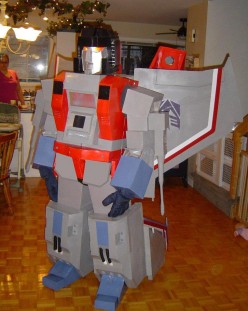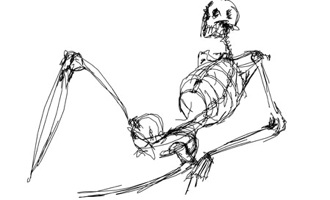Henry David Thoreau: "'I stand in awe of my body.'"
Sunday, November 27, 2005
J. K. Rowling: "'His priority did not seem to be to teach them what he knew, but rather to impress upon them that nothing, not even... knowledge, was foolproof.'"
08:52 PM
ouch
shoulda seen it comin too
Star Wars Episode III: Revenge Of The Sith: "
Reviewed by a panel
Quote: 'Looking over the major plot elements, one comes away from the film convinced that everyone in Lucas's future past is a putz. Anakin knows his wife and child(ren) are in danger, so what does he do? Does he take them and travel to an exile planet in hopes of avoiding both the Jedi and the Sith? Nope, he just whines like a wuss and walks right into the Emperor's incredibly hokey trap.'
(Via DVD Verdict.)
08:36 PM
If hackers ruled the Earth photoshopping contest: "Cory Doctorow:
Today on the Worth 1000 photoshopping contest: hackerish versions of everyday objects. I love the Vegas sign (pictured here) and especially the ASCII Bits cereal.
Link
"
(Via Boing Boing.)
08:33 PM
mmmmm robots
Transformers costumes that turn into cars and jets: "Cory Doctorow:
Mark of Marksprojects has built a series of working Transformers costumes. They can transform from robots to cars/jets while you wear them. No build-logs but he sells the transformable versions for nearly four grand (!). Someone needs to deliver a set of open source plans for these!
Link
(Thanks, Marsolais!)
Update: To clarify -- There's an audience for these things who will pay $3,750 for this. They're cash-rich and time-poor. There's another audience who will never pay $3,750 for one of these, but might happily spend a year putting one together in their basements: time-rich and cash-poor. The time-rich people would likely never avail themselves of a set of plans for this, so a set of open plans would not displace sales of the costumes, but it would encourage a generation of cardboard hackers who'll go on to deliver new and better costumes in years to come -- it's the best of both worlds.
"
(Via Boing Boing.)
Wednesday, November 23, 2005
09:30 PM
Typographers ponder ligatures for WTF, LOL: "Xeni Jardin:
On Typophile discussion boards, typographers are considering the evolution -- in a non-digital, alternate universe -- of ligature styles for the common internet expressions 'wtf' and 'lol'.
Link
(Thanks, Rebecca Blood)
(Via Boing Boing.)
09:23 PM
this for my bro who was just visiting, a deisneyphile
Disneyland ride 3D videos as a podcast: "Cory Doctorow:
Back in March 2004, we blogged about a guy who makes red/blue stereoscopic 3D movies of Disney rides. Now he's launched them as a video podcast feed -- get 3D Disneyland ride-throughs delivered to your desktop!
Link
(Thanks, Waltsentme!)
(Via Boing Boing.)
09:16 PM
there's a stocking stuffer
Crocheted Flying Spaghetti Monster dildo cozy: "Xeni Jardin:
Link (Thanks, Jennifer)"
(Via Boing Boing.)
09:15 PM
Electric fish jam rivals: "David Pescovitz:
When an electric knifefish encounters a rival, both boost their electric field in an effort to jam the other's signal. Previous research has shown that distorting the fish's electric field screwes up its 'guidance systems.' The scientists who conducted the experiments, Sara Tallarovic of the University of the Incarnate Word and Harold Zakon of the University of Texas, recorded knightfish fish doing battle, including the zaps converted into audible sound. The intense videos are available as part of a Science News article about the research. From the article:
A fish of this species occasionally raises its frequency but never lowers it, Tallarovic says. She suspected signal jamming when she noticed upward frequency shifts as one fish attacked another. 'Everybody just told me, 'No, it's got to be an artifact,'' she says.
So, she and Zakon monitored fishes' electric fields in several scenarios, the team reports in an upcoming Animal Behaviour. When researchers put two fish in an unfamiliar tank or used a field-emitting dummy to mimic an intruder in a fish's home tank, both males and females tended to raise their electric-field frequencies as they attacked. The changes' timing and context convinced the researchers that the attacking fish was jamming the other's signals.
Link"
(Via Boing Boing.)
Tuesday, November 15, 2005
11:30 PM
Time-lapse figure drawing: "David Pescovitz:
I'm taking my first drawing class ever and this time-lapse Flash animation of a figure being sketched drives me wild.
Link (via Drawn!)"
(Via Boing Boing.)
11:24 PM
Phobias illustrated photoshopping contest: "Cory Doctorow:
Today on the Worth1000 photoshopping contest: phobias illustrated. There are so many squicks on this page -- I've discovered fears I never knew I had.
Link
(Via Boing Boing.)
Friday, November 11, 2005
Will Rogers: "'Don't gamble; take all your savings and buy some good stock and hold it till it goes up, then sell it. If it don't go up, don't buy it.'"
08:35 PM
Propeller Beanies / The story of the geek's icon: "
When I write technical books and articles, I generally assume my audience is composed of ordinary people, not programmers or computer experts. I try to provide enough context and detail so that any reasonably intelligent person can get the gist of what I’m saying, even without prior experience in the topic I’m discussing. But in one of my ebooks, I described a certain procedure that, because it was somewhat complex, should only be attempted by those with a fair amount of computer know-how. The way I put it was this: ‘Unlike everything else in this book, this rather involved (and entirely optional) technique does require you to wear a propeller beanie…’
A few months later, I got an email from the man who was translating the book into German. His very reasonable question: ‘What is a propeller beanie?’
I found it surprisingly difficult to answer the question. I can describe what a propeller beanie looks like, but if the translator put the German equivalent for ‘child’s skullcap with a decorative plastic propeller’ in the book, that would not be meaningful to the readers—they’d wonder, ‘Why must I wear a silly hat to be able to do such-and-such with my computer?’ After explaining, as best I could, the cultural significance of the propeller beanie in America, I told the translator that it would be best just to say, ‘This technique requires you to be technically proficient.’ I have no idea if there is any shorthand symbol in German that represents the same bundle of ideas that the propeller beanie does in English. But this exchange, besides bringing back memories of graduate linguistics courses in the problems of translation, made me wonder where the propeller beanie actually came from, and how it came to mean what it does today.
Putting On Your Thinking Cap
Science fiction author and cartoonist Ray Nelson claims to have invented the propeller beanie while still a high school student in 1947. The story is that he and some friends decided to take some pictures parodying science-fiction icons of the day. To represent a hero with an antigravity device, someone decided they should put a propeller on a hat, and Nelson quickly put one together from scraps of plastic he had lying around his room. One of his friends, George Young, believed at the time (and apparently still does) that Nelson bought the cap at a dime store rather than making it himself; Nelson maintains to this day that the cap was his invention. In any case, they all agreed the propeller beanie was a great joke, and Young later wore the hat at a science fiction convention—to much general approval. So Nelson drew a cartoon featuring Young in a propeller beanie as a symbol of science fiction fans. This cartoon led to other cartoons and eventually to an animated TV show called ‘Beany and Cecil’ in which one of the characters, Beany Boy, wore the eponymous propeller beanie. The show in turn led inevitably to merchandising, and thus a cultural phenomenon was born.
There being (as far as I’ve been able to determine) no drawings or stories of the propeller beanie that predate Nelson’s claim, I believe that he did in fact invent it. Due to a series of misunderstandings, Nelson was not properly credited with the invention when it was first commercialized, and though the manufacturer (and the cartoonist from whom they licensed the design) made millions on the propeller beanie, Nelson himself received none of that money. In any case, no one disputes that Nelson was responsible for popularizing the propeller beanie through his cartoons.
Mark of the Geeks
Meanwhile, the sci-fi fans who had made their own propeller beanies by hand and worn them proudly when they were an ‘in’ joke stopped wearing them as soon as they became popular among the mainstream youth of America. Although the propeller beanie appeared in comics for years afterward, the fad itself soon faded, and any child over a certain age who still wore such a cap was considered socially unsophisticated—reinforcing the stereotype of the science fiction fan as being out of touch with reality (including fashion trends). Eventually, however, computer enthusiasts resurrected the propeller beanie as a self-deprecating badge of honor—as if to say, ‘Yes, we know we’re out of touch with reality, and we’re proud of it!’
That is the sense in which I’ve always known the propeller beanie: a representation of the nerdy programmer. In the early 1990s, I was living in Pittsburgh and working as a computer graphic artist. A few blocks from my office was the headquarters of a small software company, and I got to know several of the employees there through a mutual friend. This company (which has been out of business for many years now) had a group of faithful hangers-on who served as beta testers—people who try out new software before its release and look for bugs, so that they can be fixed before it ships. I signed on as a tester for one of their products, and dutifully found and reported as many bugs as I could. When the software shipped, they honored their best beta testers by giving them a propeller beanie and a certificate that said ‘Order of the Beanie.’ Getting my own beanie was a proud moment, and I think I still have that certificate somewhere. Later, when a friend and I started a (short-lived) consulting company called ComputerGeeks, Inc., we used a picture of a propeller beanie as our logo; our slogan was ‘We’re geeks so you don’t have to be.’
The classic propeller beanie is brimless and multicolored, typically with alternating wedges of yellow and red. Some modern designs add a brim—effectively making it into a baseball cap with a propeller. You can even find motorized propeller beanies. What you cannot find, of course, is a propeller beanie with enough lift to fly off your head—much less take you with it. But the computer geek culture actually uses the propeller beanie in much the same way as it was originally intended: a way to make fun of oneself and the sillier side of the technology we love.—JK
[ Permalink ]
More Information...
This article is also available as an audio recording! By signing up for a one-year subscription to Interesting Thing of the Day for just $10, you’ll get full access to each daily article as a podcast, plus the option to receive the articles by email. (To hear sample recordings, visit our Subscriptions page.)
The version of the propeller beanie’s origin I regard as definitive is the one told by Ray Nelson himself at the Historical Boys’ Clothing* site. You can read much more by and about Ray on his Web site, RayNelson.com.
Other versions of the story:
- Where Propheads Come From by Loren MacGregor
- Where Propheads Come From—A Second View by Robert J. Vitello
- Propellar [sic] Beanies* and Boys’ Caps: Beanies* at Historical Boys’ Clothing (the same site that featured Ray Nelson’s story)
- Comments by Chad Childers on Roymeo’s Blog
*Note that when viewing certain pages on the Historical Boys’ Clothing site, you will be asked for a username password. You can click Cancel each time such a request appears; the effect will be that certain graphics will not appear on the pages. The site asks for a contribution of $25 to enable viewing the images, but you can read the text of the articles without becoming a subscriber.
In 1950, Jerome Lemelson patented a variation on the propeller beanie that provided a tube the wearer could blow into to spin the propeller.
You can buy the classic (multicolored, brimless) propeller beanie from such online sources as Archie McPhee, VillageHatShop.com, and Hats in the Belfry.
Related Articles from Interesting Thing of the Day
Virtual Tip Jar
Did you find this article interesting, entertaining, or useful? If so, please consider donating a few dollars to the author to support the ongoing development of Interesting Thing of the Day.
[Donate via: Amazon.com Honor System | Other/More Information]
© 2004, alt concepts, inc.
"(Via Interesting Thing of the Day.)
08:17 PM
Web Zen: Robots: "Xeni Jardin:
quilts | paintings | comix | robot bastard | bitterbots | toy robot auction | spanish + latin american robots | robot village |
kiss institute |
mo'bots
web zen home, web zen store, (Thanks, Frank)."
(Via Boing Boing.)
Sunday, November 6, 2005
Sunday, November 06, 2005
09:15 PM
Marvel Comix 1976 coloring book: "Cory Doctorow:

A reader writes, 'Ape Lad, flickr hobo cartoonist extraordinaire, has created a new photo set featuring scans of the 1976 Marvel Fun Book, starring the ever-lovin' Stan Lee as Thor.'
"
(Via Boing Boing.)
Sunday, November 06, 2005
09:13 PM
Oh I say R2
Robot rescues bird: "David Pescovitz:
A bomb-disarming robot rescued a pet bird named Tweety from a collapsed apartment building in Sydney, Australia. From the BBC News:
Tweety the cockatiel was stranded for two days after the building partially collapsed, undermined by a new tunnel.Link(Thanks, Paul Saffo!)"No-one, including Tweety's owner Karen Bruce, was allowed into the building because police deemed it too dangerous.
But help came in the form of a remote-controlled robot, which emerged from the building carrying Tweety in her cage.
(Via Boing Boing.)
How I learned to stop worrying and love Dan Lyon's blogosmear in Forbes: "Xeni Jardin:
Snip from 'Forbes Fumbles the Blogosphere: Does an Attack on Bloggers Signal the Dawn of Blogosphere-Dominant Media?,' an ABC News commentary by Michael Malone (who used to run Forbes' technology magazine, Forbes ASAP):
Let me make a prediction. Five years from now, the blogosphere will have developed into a powerful economic engine that has all but driven newspapers into oblivion, has morphed (thanks to cell phone cameras) into a video medium that challenges television news, and has created a whole new group of major companies and media superstars. Billions of dollars will be made by those prescient enough to either get on board or invest in these companies. At this point, the industry will then undergo its first shakeout, with the loss of perhaps several million blogs — though the overall industry will continue to grow at a steady pace.
And, at about that moment, Forbes will announce that the blogosphere is the Next Big Thing for investors.
Link (gracias, Antonio Delgado)"
(Via Boing Boing.)
Sunday, November 06, 2005
09:11 PM
I say yeah
How to boost your happiness level immediately: start throwing stuff away: "Mark Frauenfelder:
If you aren't getting rid of your possesions at the same rate you are acquiring them, your living space is getting more and more cluttered. Clutter depresses me. I love getting rid of junk. Here's a great column by Mark Morford of the SF Gate on the joy of de-gunking your pad.
The cure is simple, so graceful that it will make you feel lighter and healthier and good the minute you start, and of course you can start right now and you don’t even need any drugs or wine or nudity, though those always, always help.This is what you do: You throw stuff out. You go through your closets and you fill up garbage bags and you even grab stuff you’ve clung to for years for no apparent reason, and you haul it all down to Goodwill or Salvation Army or (in the case of San Francisco) leave the usable stuff out in the street overnight and let the urban recycling phenomenon work its magic, as some lucky passerby scores your old futon and the three grungy frying pans you haven’t used since 1987.
Link (via 43 Folders)"
(Via Boing Boing.)
Sunday, November 06, 2005
09:07 PM
love that wacky
Photos: kitschy Christian tracts: "Xeni Jardin:
A Flickr photo pool dedicated to wacky religious ephemera. Some items are obliquely erotic.
Link to pool
(Thanks, Brian Sawyer)
Previously on Boing Boing:
Awesomely weird Jehovah's Witness art
"
(Via Boing Boing.)
Wednesday, November 2, 2005
09:17 PM
for u disney-philes
Talking kitchen-trash can burps when it's full: "Cory Doctorow:
An NYU student is planning to build an animatronic trash-can that extends the functionality of Walt Disney World's talking trash-can:
Link
The trash can and recycling bins are a modular set that would gives both sound and visual feedback. the trash can would only make a sound when you open it (i.e. open it's mouth). For example, when you throw something out, and the can is near full, it can belch. When it gets very damp (using a moisture detector), often an indication that the trash is more prone to germs, smells, etc., it can cry. When you open it up to take out the trash, and change the liner and you have the most contact with i, it can giggle, as in being tickled. The sounds don't need to be so human, animal, or literal. But, with the sounds, the trash can takes on some 'creature' behaviour.
(Thanks, John!)
Update: Ken sez, 'Some years ago several fast food chains tried interactive trash cans--there's a reference in the link to robotic trash cans at Taco Bell. I was in a Burger King a few years ago that had trash cans in the play area which talked to the children, 'thanks for the trash!', that sort of thing. It was probably designed to get people to put their own trash away so the staff wouldn't have to do it, but what actually happened was that children would put their heads into the trash cans to see who was inside there. This caused their little heads to be caught in the manner of a squirrel trap. It was somewhat dangerous but very funny. Next time I went to Burger King the interactive trash cans were gone.'
(Via Boing Boing.)
Tuesday, November 1, 2005
Automator to the Rescue: "Want to learn more about Automator, the new application that ships with Mac OS 10.4 Tiger? This is the article for you."
(Via MyMac.com.)
10:27 PM
heh heh
Which body parts are most vulnerable to solar flares?: "Xeni Jardin:
If you're an astronaut, you'll want to click here to see the answers NASA researchers have come up with.
(Via Boing Boing.)
10:26 PM
Web Zen: zombie zen: "Xeni Jardin:
we're not using the zed word |
so you wanna be a zombie |
deanimator |
zombie walk |
the sneeze on zombies |
zombie quiz |
how to survive a zombie epidemic |
knitted dawn of the dead |
shaun of the dead
web zen home, web zen store, (Thanks, Frank).
Bonus, zombie-like action: Peter Beste's photographic portraits of black metal devotees: Link (Thanks, Sean Bonner)
(Via Boing Boing.)




